Democratic backsliding
Forms of democratic decline
General question for political science: how to think about institutional change?
- One way: there is a high level of institutional stability, interrupted by short, intensive periods of change (punctuated equilibrium).
- Focus on revolutions, (civil) wars, big constitutional reforms…
- Example: democracy expanded in waves.
- Another way: most change occurs slowly and gradually, it is hard to identify a single tipping point:
- Focus on slow-moving factors such as value change, demography, technological change, gradual political reforms.
- Example: (endogenous) modernisation theory.
Why this session?
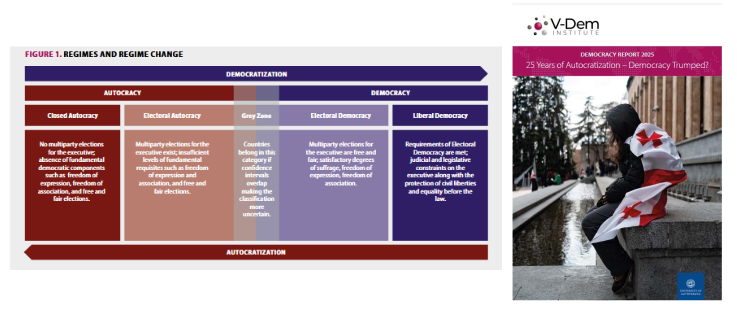 Autocratisation is not absolute or shows the same way across countries. Not all countries start and end in the same place, neither do they follow the same processes.
Autocratisation is not absolute or shows the same way across countries. Not all countries start and end in the same place, neither do they follow the same processes.
 Very actual topic, autocratisation is on the rise.
Very actual topic, autocratisation is on the rise.
Breakdown or backsliding
- In the 20th century, the dominant danger to democracies was breakdown: democracies transitioned quickly to a new regime.
- Noticeable most of the time.
- Forms: Coups, Autogolpes (executive coups), Invasions.
- Examples: Germany 1933, France 1940, Greece 1967, Argentina 1976
- This fits the dichotomous measure used in Przeworski/Limongi. If breakdown is clearcut, a dichotomous measure can capture it.
Nowadays
- In the 21st century, rapid transitions have become the exception.
- Today, we mainly observe a gradual decline of democracy.
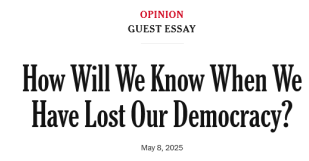
- The disappearance of democracy will not be clear, but up to debate.
Forms of democratic breakdown

Coups

- Greece 1967, Chile 1973, Argentina 1976, Spain (failed) 1981.
- But: Niger 2023, Gabon 2023, Burkina Faso 2022, Mali 2021… (not completely over as the data would suggest)
- Prigozhin 2023?
- Turkey 2016.
How coups look in datasets
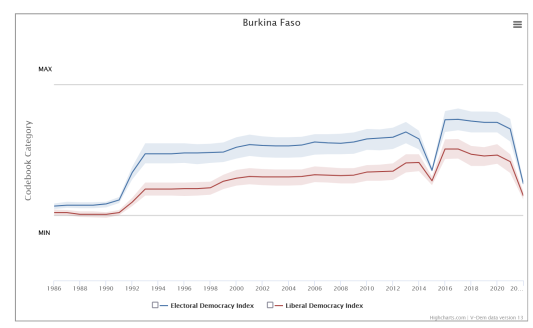
Conclusion
- The optimism about coups seems less well founded from today’s point of view.
- So far, they mainly affect countries that are non-democratic or where democracy is very unstable.
- But: Was January 6th 2021 in the United States an attempt at a autogolpe/self-coup?
Definition of backsliding
- The more common phenomenon today, in particular in established democracies.
- Democracies still die, but by different means…Democratic backsliding today begins at the ballot box. (Levitsky/Ziblatt, 2018. How democracies die, p. 5).
- Bermeo: state-led debilitation or elimination of any of the political institutions that sustain an existing democracy. (p. 5).
How backsliding looks in datasets

How does backsliding look in practice
- Promissory coups instead of open-ended coups
- Executive aggrandisement instead of executive coups.
- Weaponizing the state.
- Strategic harassment and manipulation instead of election-day vote fraud.
Promissory instead of open-ended coups
A first persistent variety of backsliding involves what might best be called promissory coups. Promissory coups frame the ouster of an elected government as a defence of democratic legality and make a public promise to hold elections and restore democracy as soon as possible. Whereas Cold War coupmakers usually cast their seizures of power as open-ended, most coupmakers today emphasise the temporary nature of their intervention and frame it as a necessary step towards a new and improved democratic order.
Critique
…not so promissory after all: The promised elections that are essential to promissory coups, when they do actually occur, are nearly never free or fair. Few have resulted in a return to power for the ousted government or the loss of the coup-maker’s preferred candidate, and even fewer were accepted by the ousters as legitimate. Indeed, Bermeo is only able to provide one example of the described phenomenon that resulted in an improvement of political liberties or civil rights.
Executive Aggrandisement
Bermeo: when elected executives weaken checks on executive power one by one, undertaking a series of institutional changes that hamper the power of opposition forces to challenge executive preferences.
Steps towards competitive authoritarianism:
- Increase government control over the media.
- Weaken courts or increase government control over them.
- Reduce competencies of parliaments, increase those of the executive.
Example: courts
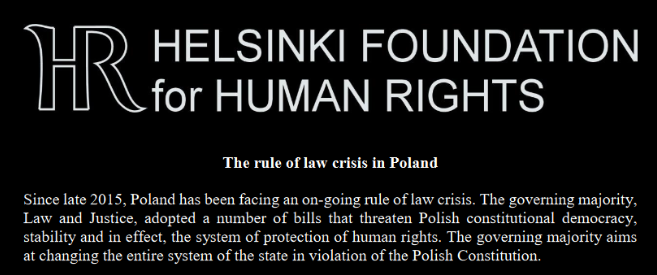 In the end this wasn’t completely true, Donald Tusk won the elections→we can’t always trust expert reports.
In the end this wasn’t completely true, Donald Tusk won the elections→we can’t always trust expert reports.

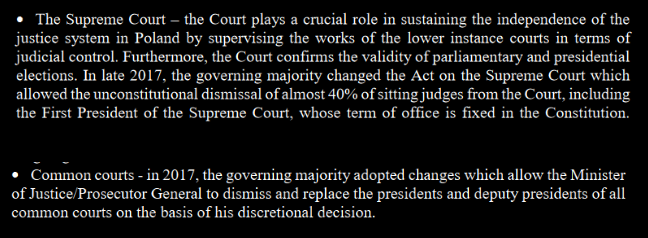 Another example could be the attacks of the British press towards judges:
Another example could be the attacks of the British press towards judges:

Example: media
 Voters who were not susceptible to such overt threats were nonetheless swimming in a media environment in which the government’s message was the only one they heard. As Orbán has consolidated his grip on Hungary, his control of the media is now nearly absolute. In 2010, he cut all state advertising funds to critical news outlets and threatened to sever contracts with private advertisers that continued to support targeted media. The following year, he established a Fidesz-controlled media council with the power to levy bankrupting fines against news outlets that did not favor the Fidesz worldview.
Voters who were not susceptible to such overt threats were nonetheless swimming in a media environment in which the government’s message was the only one they heard. As Orbán has consolidated his grip on Hungary, his control of the media is now nearly absolute. In 2010, he cut all state advertising funds to critical news outlets and threatened to sever contracts with private advertisers that continued to support targeted media. The following year, he established a Fidesz-controlled media council with the power to levy bankrupting fines against news outlets that did not favor the Fidesz worldview.
- It is also possible, as a competitive autocrat, to threaten TV channels with the revocation of their streaming license among other things. Hit on all sides by financial attacks, independent and opposition media began to fail just as news media across the globe were struggling financially to adapt to the online world. It was therefore not obvious outside Hungary that the country’s media companies were failing for different reasons. Once they were sufficiently weakened, however, these starved outlets could be bought for cheap. Orbán’s close friends snapped up many of them at the Fidesz fire sale—at which point state advertising resumed to sustain them. Rather than jailing journalists, engaging in blatant censorship, or simply shuttering hostile media, Orbán let economic pressure do the work.
- Jailing journalists may be an objective but insufficient measure. It is not the only way to measure media control.
- In countries such as the USA they are also in a position to collaborate with social media personalities, something that other countries find more difficult.
Weaponizing the state
- Levitsky/Way 2025 (background reading next week): much of the coming authoritarianism will take a less visible form: the politicisation and weaponisation of government bureaucracy.
- The most visible means of weaponizing the state is through targeted prosecution. Virtually all elected autocratic governments deploy justice ministries, public prosecutors’ offices, and tax and intelligence agencies to investigate and prosecute rival politicians, media companies, editors, journalists, business leaders, universities, and other critics.
Example: tax charges


Example: mortgage fraud

Strategic election manipulation
- Bermeo: Today, only amateurs steal elections on election day.
- They do not simply miscount votes any longer.
- These include hampering media access, using government funds for incumbent campaigns, keeping opposition candidates off the ballot, hampering voter registration, packing electoral commissions, changing electoral rules to favor incumbents, and harassing opponents—but all done in such a way that the elections themselves do not appear fraudulent.
- Steps towards competitive authoritarianism.
Example: Hungary
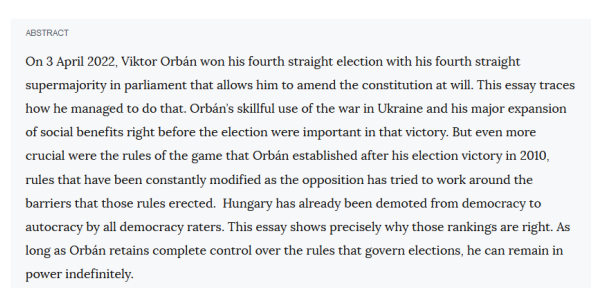
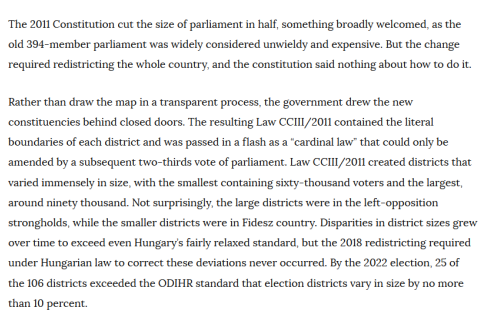

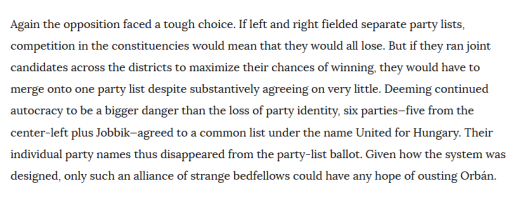
 Why do voters continue to support this? Many potential explanations, but one that is particularly relevant in this case→affective polarisation.
Why do voters continue to support this? Many potential explanations, but one that is particularly relevant in this case→affective polarisation.
Affective polarisation
Definition
- A tendency for supporters of one party to dislike and distrust the supporters of another party.
- Different from ideological polarisation, which is about policy differences.
- Introduces an unwillingness to interact with the other side even in non-political settings.
- E.g.: In 1960, 4–5% of Americans reported that they were unhappy if their child married someone from the out party. By 2010, it was one-third of Democrats and one-half of Republicans.
- Parties acquire ownership of issues and people don’t support policies to solve them based on objective properties, but on their subjective affective connection to the party that owns it.
- This happens a lot in the USA: when a new issue appears it’s a matter of time before it’s a democrat or republican issue.
Why is this relevant for democratic backsliding?
- In a healthy democracy, your opponent is your rival, not your enemy.
- In particular, the turnover of power means that today’s majority can be tomorrow’s minority.
- This induces a restraint in the use of power: you want to keep checks on the treatment of the minority.
- While there are divisions about questions of policy, there is an underlying joint commitment to the institutional order.
- All of this becomes precarious when the opponent becomes the enemy:
- An enemy must not be allowed to take power.
- It is legitimate to bend or break institutional norms to prevent this from happening.